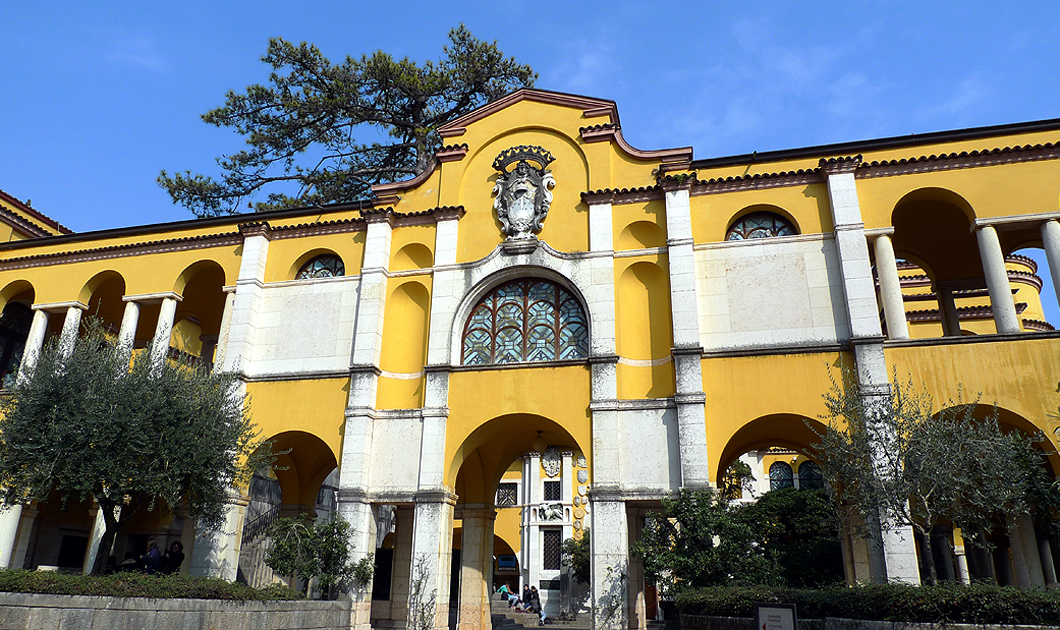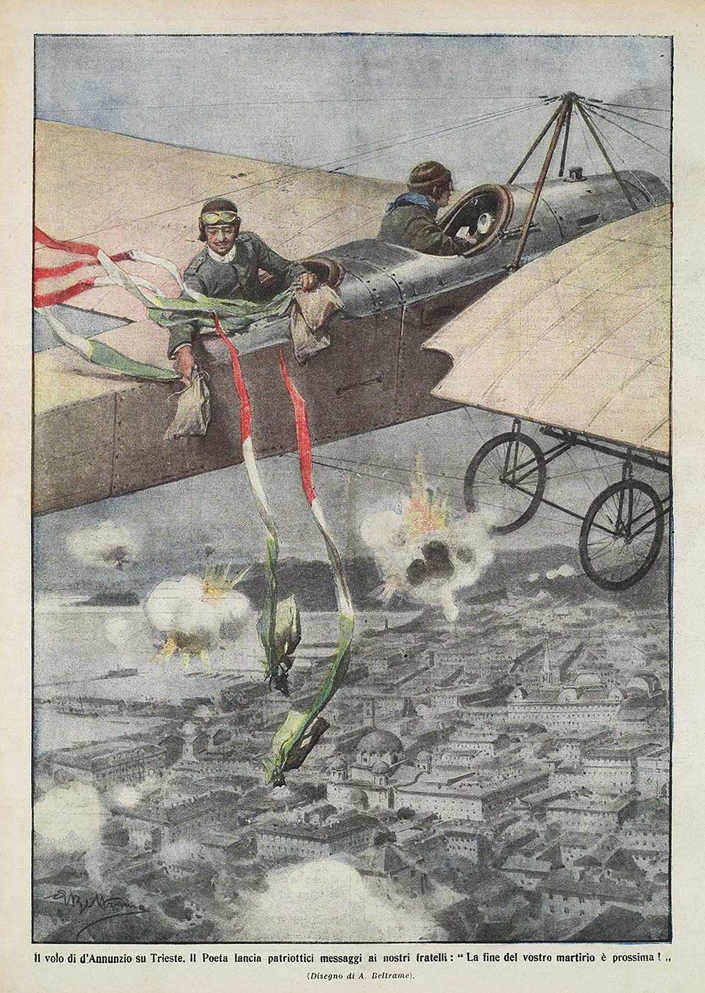|
Il
Vittoriale degli Italiani |
 |
|
 |
hjem og
monument for General Gabriele
D'Annunzio
home and
monument to General Gabriele D'Annunzio |
 |
|
Vittoriale degli
Italiani (de italienske
sejres helligdom) i
Gadone Riviera var det
hjem og monument som
General Gabriele
D'Annunzio (1863-1938),
prins af Montenevoso og
hertug af Gallese skabte
for sig selv. Dandyen D'Annunzio
var en italiensk
forfatter (kaldet Il
Vate, nationaldigteren), journalist,
dramatiker og soldat
under
1. Verdenskrig.
Han blev født i Pescara
i regionen Abruzzo, der
nogle år tidligere havde
været en del af
"Kongeriget de to
Sicilier" (1816-61).
D'Annunzio døde 74 år
gammel i Gardone Riviera
på vestkysten af
Gardasøen. D'Annunzio
var døbt Gaetano
Rapagnetta. Hans
forældre var Franscesco
Paolo Rapagnetta og
Luisa de Benedictis.
Navnet Gabriele
D'Annunzio betyder
"Gabriel bebuderen", det
er ærkeenglen Gabriel,
der bebuder Jesu fødsel
for Jomfru Maria.
D'Annunzio var gift med
Maria Hardouin fra
1883-91, sammen fik de
tre børn.
Han havde utallige
kvindebekendtskaber bl.a. den
milanesiske aristokrat
Luisa Casati (1881-1957)
samt den italienske
skuespillerinde Eleonora
Duse (1858-1924), der
tolkede både D'Annunzios
poetiske dramaer og
Henrik Ibsens
kvindeskikkelser.
Under 1. Verdenskrig
ændredes opfattelsen af
D'Annunzio fra litterær
figur til national
krigshelt. Han var i
specialstyrken Arditi
(de modige) i den
kongelige italienske
hær. Den 8. september
1920 bekendtgjorde
D'Annunzio "La Carta del
Carnaro", en forfatning
som erklærede Fiume for
selvstændig
og med ham selv som
"duce" (føreren).
Forfatningen varslede
det senere italienske
fascistiske system og
dets leder Benito
Mussolini, "Il Duce".
I komplekset ved
Gardasøen boede
D'Annunzio fra 1922 til
sin død i 1938. Området
består af hans private
bolig kaldet "La Priora"
(munkeklosteret), et
amfiteater, krydseren
"Puglia", der er
placeret i bjergsiden,
et bådhus med MAS, et
fartøj D'Annunzio
anvendte i 1918
samt
hans mausoleum.
Il Vittoriale er omtalt
som både et storslået
citadel og en fascistisk
vanvidspark.
Den oprindelige
hovedbygning var
Villa Cargnacco,
der havde tilhørt en
tysk kunsthistoriker, og
den beslaglagde
D'Annunzio med
Mussolinis billigelse,
og lod sin arkitekt
Giancarlo Maroni
udvide og ombygge
stedet. La Priora er i
dag museum, der er
bl.a. et flygel, der har
tilhørt Franz Liszt.
D'Annunzio sammenlignede
sig med
Dante Alighieri og
Michelangelo. Han
var en mand med stor
kærlighed til sig selv,
en Narcissus samt en
mytemager. I sin bolig
skabte han et rum til
sit dødsleje, som han
kaldte
spedalskhedsrummet. Sengen er
placeret på en lille
forhøjning, der fører
leopardskindsdækkede
trapper op til det
vuggelignende leje. D'Annunzios bolig er
meget mørkt fordi lys
generede ham. Han
mistede det ene øje ved
en flyulykke.
"The
Randy Dandy" (Den
liderlige dandy),
artikel i New York
Times, september 2009 af
Grazia D'Annunzio. |
The Vittoriale
degli Italiani
(the shrine of
Italian
victories) was
the home and
monument to General
Gabriele
D'Annunzio
(1863-1938),
Prince of
Montenevoso,
duke of Gallese
established to
himself.
D'Annunzio was a
flamboyant
and eccentric
Italian writer,
journalist,
playwright and
soldier during
World War I. He
was born in
Pescara in the
region of
Abruzzo which
few years
earlier was part
of "The Kingdom
of the Two
Sicilies",
(1816-61).
D'Annunzio died
at the age of 74
in Gardone
Riviera at the
west coast of
Lake Garda in
Northern Italy.
D'Annunzio
was born Gaetano
Rapagnetta. His
parents were
Franscesco Paolo
Rapagnetta and
Luisa de
Benedictis.
The name
Gabriele
D'Annunzio means
"Gabriel of the
Annunciation",
the angel
Gabriel
announces the
birth of Christ
to Virgin Mary.
D'Annunzio was
married to Maria
Hardouin
from 1883-91,
together they
have three
children.
He had multiple
affairs among them were
Eleonora Duse
(1858-1924),
Italian actress,
and the Milanese
aristocrat Luisa
Casati
(1881-1957).
During World War
I the
perception of
D'Annunzio was
transformed from
literary figure
into a national
hero. He was
associated to
the special
forces of Italy,
Arditi. On
September 8,
1920 D'Annuncio
promulgated "La
Carta del
Carnaro", a
constitution
that declared
Fiume to be autonomous
with
himself as duce
(the leader).
The constitution
foreshadowed the
later Italian
Fascist system
and its leader Benito
Mussolini, "Il
Duce".
D'Annunzio
lived in the
complex at Lake
Garda from 1922
until his death
in 1938. The
estate contains
his private
residence called
"La Priora"
(monastery), an
amphitheatre,
the cruiser
"Puglia" in the
hillside, the
vessel MAS and
his mausoleum.
Il Vittoriale
has been called
af momumental
citadel and a
fascist
lunapark.
The original
main building
Villa Cargnacco,
had belonged to
a German art
historian, and
was
seized by
D'Annunzio with
Mussolini's approval and reconstructed by
D'Annunzio's
architect
Giancarlo
Maroni. La
Priora is today museum
and among the
effects is a
piano which has
belonged to
Franz Liszt.
D’Annunzio
compared himself
to Dante
Alighieri and
Michelangelo.
He was a man in
love with
himself, a
Narcissus, and a
personal
mythmaker. He
created what's
called the
"Leper's Room",
where he would
be laid out on
his deathbed,
leopard-skin
rugs and steps
leads up to the
cradle bed.
There are low
ceilings and
darkness in his
house, darkness
because bright
light hurt his
eyes. He could
not bear the
daylight, mayby
that's the
reason why he
create a world
of his own
inside the
house.
"The
Randy Dandy",
article in New
York Times,
september 2009
by Grazia
D'Annunzio. |
 |
 |
 |
 |
 |
|
"La Priora"
(munkeklosteret),
D'Annunzios private bolig/"La Priora"(monastery),
D'Annunzio's private
residence. |
 |
|
|
|
|
1 |
Buste af D'Annunzio/Bust
of D'Annunzio. |
|
2-4 |
"La Priora"
(munkeklosteret),
D'Annunzios private bolig/"La Priora"(monastery),
D'Annunzio's private
residence. |
|
 |
|
|
|
1-4 |
"La Priora"
(munkeklosteret),
D'Annunzios private bolig/"La Priora"(monastery),
D'Annunzio's private
residence. |
|
|
 |
|
1-3 |
"La Priora"
(munkeklosteret),
D'Annunzios private bolig.
"La Priora"(monastery),
D'Annunzio's private residence. |
|
2-3 |
Piazzetta dalmata. |
|
4-6 |
Museo "D'Annunzio segreto". |
|
|
|
|
 |
|
|
|
|
 |
|
|
|
1-4 |
D'Annunzios kiste blev
på hans begravelsesdag transporteret på denne
kanonlavet.
D'Annunzio's coffin was transported at this
cannon lavette the day he was buried. |
|
 |
|
|
|
1 |
D'Annunzios kiste blev
på hans begravelsesdag transporteret på denne
kanonlavet.
D'Annunzio's coffin was transported at this
cannon lavette the day he was buried. |
|
2 |
D'Annunzios Isotta Fraschini fra 1936/D'Annunzio's Isotta Fraschini from 1936. |
|
3 |
Propagandaflyvningen over Wien den 9. august 1918 var iværksat af D'Annunzio og foregik i biplanfly af modellen Ansaldo SVA. 50.000 foldere, forfattet af D'Annunzio, blev kastet ned.
The propaganda flight over Vienna on August 9, 1918 in biplane Ansaldo SVA, was arranged by D'Annunzio. 50.000 leaflets, written by D'Annunzio were dropped. |
|
 |
|
|
|
|
|
1-4 |
Den beskyttede
krydser "Puglia"/The protected cruiser
"Puglia".
|
|
 |
|
|
|
|
 |
|
|
|
1-3 |
Memento Audere Semper
(husk altid
at turde), D'Annunzios motto og
akronym for MAS. Motortorpedobåden MAS 96
blev brugt af D'Annunzio i nogle af hans eventyrer
under 1. Verdenskrig.
Memento Audere Semper
(remember always to dare), D'Annunzios motto and
acronym for MAS. The fast patrol boat MAS 96
was used by D'Annunzio in some of his World War I
adventures. |
|
 |
|
|
 |
|
|
|
|
|
|
 |
|
|
|
1-2 |
Amfiteatret er
opført efter klassiske eksempler. Giancarlo Maroni,
D'Annunzios arkitekt, besøgte
Pompeji for at hente
inspiration.
The amphitheatre is influenced by
classical architecture. Giancarlo Maroni,
D'Annunzio's architect, wisited
Pompeii for
inspiration. |
|
 |
|
|
|
1-4 |
D'Annunzio døde i 1938
og fik en statsbegravelse foranlediget af Mussolini.
Det cirkulære mausoleum blev tegnet efter
D'Annunzios død, men først opført i 1955, og
D'Annunzios jordiske rester blev bragt til mausoleet
i 1963. I mausoleet er også de jordiske rester af de
mænd som tjente D'Annunzio. D'Annunzios grav er
omgivet af sarkofager, der indeholder hans skotske
greyhounds. Hundevæddeløb optog D'Annunzio i en
sådan grad, at han besluttede at skrive en bog om
hunde og deres beundringsværdige gerninger, hvilket
imidlertid ikke blev til noget.
D'Annunzio was given a state funeral by
Mussolini. The circular mausoleum was designed after
his death and built in 1955. D'Annuzio's remains
were brought there in 1963. The mausoleum also
contains the remains of men who served D'Anunzio.
D'Annunzio's tomb is surrounded sarcophagi
containing his Scottish Greyhounds. |
|
 |
|
|
|
|
|
|
|
|
|
|
|
|
|
 |
 |
 |
D'Annunzio
flyvning
over
Trieste
hvor
der
kastes
bomber
og
flyveblade.
Den
ugentlige
italienske
avis
"Domenica
del
Corriere",
22.
august,
1915.
Fly of
D'Annunzio
over
Trieste.
The
weekly
Italian
newspaper
"Domenica
del
Corriere",
22.
August,
1915. |
|
|
|
|
|
|

